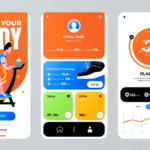The modern competitive mobile environment sees businesses in a continuous quest to find smarter methods of developing apps in the cheapest manner possible. And no one is alone in wondering how hybrid application development can save money. Startups, as well as worldwide organizations, are actively considering hybrid structures, such as Flutter, Ionic, and React Native, to cut back on development time, reduce operational costs, and provide users with exquisite experiences nonetheless.
The Real Problem: Traditional App Development Is Expensive
Creating a mobile app now no longer requires writing a piece of code but complexity management. Native development can increase the cost of a project by two or even three times because of separate iOS and Android development teams, duplication of codebases and varying test processes.
For example:
- Two specialized teams will result in two times the salaries.
- Keeping distinct updates heightens long term expenses.
- The parity of the features between platforms involves additional coordination.
This model is not viable to businesses that have low budgets. It is there that hybrid app development transforms the game so that you can launch more quickly but still, be cross-platform consistent.

What Makes Hybrid Development a Cost-Saving Game Changer
Hybrid app development uses a single codebase to run on multiple platforms. This simple but powerful shift drastically changes your financial landscape. Here’s how:
1. Single Codebase, Double Reach
Instead of maintaining two separate apps, developers write one set of code that works across Android, iOS, and even the web.
Savings: Reduced developer hours, unified testing, and easier updates.
Result: Faster time-to-market and consistent app behavior.
Real-World Example:
Airbnb initially ran separate native apps, but after switching to React Native, it reduced development costs by 30% and improved release velocity by 40%.
2. Faster Development Cycles
Hybrid frameworks leverage reusable UI components and pre-built libraries. This means your developers spend less time reinventing the wheel.
Savings: Quicker MVP launches and fewer integration bottlenecks.
Result: Early user feedback leads to smarter investments.
This agility is crucial for startups testing their ideas before fully committing resources.
3. Simplified Maintenance and Updates
Updating a native app requires modifying two codebases. In hybrid apps, updates are pushed once and instantly applied across all platforms.
Savings: Maintenance costs drop by up to 60%.
Result: Streamlined workflows and less dependency on large teams.
How Hybrid App Development Can Reduce Costs for Enterprises
Large organizations face unique challenges from legacy integrations to multi-department collaboration. Hybrid development offers relief through:
4. Unified Development Teams
Instead of hiring separate Swift, Kotlin, and JavaScript experts, companies can work with one cross-functional team.
Savings: Fewer hires, simplified management, and predictable budgeting.
5. Reduced QA and Testing Overheads
Testing one app instead of two halves the effort. Tools like Appius and Selenium automate this process, saving both time and costs.
Result: Quicker bug detection, faster deployments, and better quality assurance.
Addressing Common Myths About Hybrid Development
Despite its benefits, some businesses still hesitate. Let’s address the most common concerns.

Myth 1: Hybrid apps are slower than native apps.
Modern frameworks like Flutter and React Native deliver near-native performance. With proper optimization and caching, most users can’t tell the difference.
Myth 2: “You can’t access device features.”
Today’s hybrid frameworks provide full access to device APIs (camera, GPS, Bluetooth, etc.) via native bridges.
Myth 3: “Hybrid apps aren’t scalable.”
In reality, companies like Uber, Alibaba, and Instagram have successfully scaled hybrid apps to millions of users.
Hidden Costs You Can Avoid With Hybrid Development
6. Minimized Post-Launch Expenditures
Hybrid apps are easier to maintain, meaning fewer resources are needed for bug fixes and OS compatibility updates.
7. Lower Design Adaptation Costs
A shared UI layer ensures visual consistency across platforms no need for separate design systems or custom elements for each OS.
8. Reduced Infrastructure Costs
Many hybrid frameworks integrate easily with cloud-based services, lowering server and data management costs.
Key Secondary Benefits Beyond Cost Savings
While cost reduction is the highlight, hybrid app development also brings broader business advantages:
- Faster Market Validation: Ideal for MVPs and proof-of-concept apps.
- Improved ROI: Lower initial investment with sustainable scalability.
- Broader Reach: Access both Android and iOS markets simultaneously.
- Consistent Brand Experience: Unified user interface across devices.
These benefits reinforce why hybrid apps are not just a cost-saving tactic they’re a long-term growth strategy.
When Hybrid App Development Might Not Be Ideal
Despite its many strengths, hybrid development may not suit every project. It’s less optimal for:
- Apps requiring heavy 3D graphics (e.g., gaming engines).
- Projects with extensive use of low-level APIs.
- Highly customized UI animations that differ per platform.
Still, for most business apps e-commerce, fintech, healthcare, SaaS hybrid remains the most cost-effective approach.
Comparing Native vs. Hybrid: A Financial Perspective
If you’ve wondered how hybrid app development can reduce costs, look no further than the total cost of ownership (TCO). Native development doubles nearly every cost component:
- Development: 2x team size and time.
- Testing: Separate cycles per OS.
- Maintenance: Double update frequency.
Hybrid solutions reduce these redundancies, saving an estimated 30–50% over the app’s lifecycle.
How to Maximize Savings with Hybrid Development
1. Choose the Right Framework
Frameworks like Flutter, React Native, and Ionic have unique strengths. Selecting one that fits your app’s complexity ensures efficiency and performance.
2. Partner with Experienced Developers
Work with teams that specialize in cross-platform projects. Their experience helps avoid pitfalls and optimize performance.
3. Prioritize MVP Launches
Start with a Minimum Viable Product (MVP) to test your idea quickly and refine based on real feedback before scaling.
4. Invest in Reusable Components
Design UI elements and modules that can be repurposed across projects to save time and budget.
Final Thoughts
The essence of how hybrid app development can reduce costs lies in efficiency not compromise. By unifying your codebase, reducing duplication, and streamlining updates, you gain agility and financial predictability. Whether you’re a startup or a global enterprise, hybrid development empowers you to build scalable, high-performing apps without breaking the bank.
FAQs
- Is hybrid app development suitable for all types of apps?
Not always. It’s best for content-driven, service-based, or enterprise apps but less ideal for high-end gaming or hardware-intensive projects. - What are the best frameworks for hybrid app development?
Popular choices include Flutter, React Native, and Ionic all offering excellent community support and frequent updates. - How much can hybrid development reduce costs?
Typically, businesses save between 30–50% compared to building and maintaining separate native apps. - Can hybrid apps be scaled effectively for enterprise needs?
Yes. Many large organizations successfully scale hybrid apps using robust backend architectures and modular design systems.











